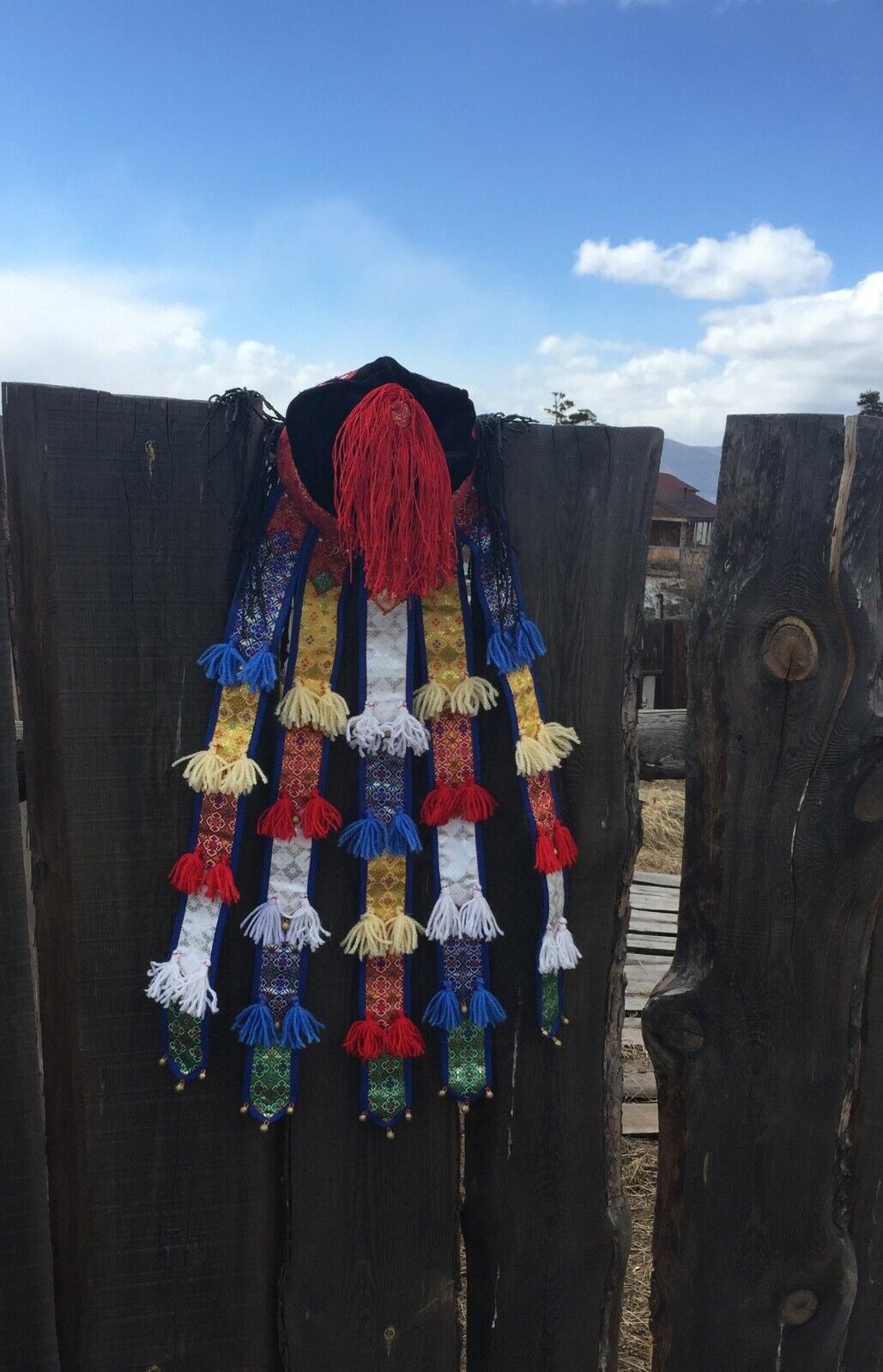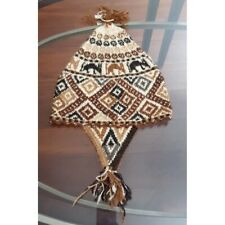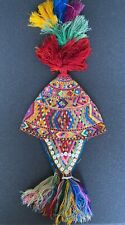Shaman hat cap Siberia For Sale

When you click on links to various merchants on this site and make a purchase, this can result in this site earning a commission. Affiliate programs and affiliations include, but are not limited to, the eBay Partner Network.
Shaman hat cap Siberia:
$286.80
Ethnic shaman hat cap (Buryatia, Siberia, Russia)Please tell us immediately the size of your head (the circumference covering the forehead and the nape of the head).Sewing time 2 weeks.Weight approximately 330 g. Any Size. Material: Mongolian silk, brocade.
Handmade.Ulan-Ude, Republic of Buryatia, Russia.Manufacturer - local seamstress.
Headdresses of shamans have a different appearance - it depends on the tradition in which the shaman performs the ritual, on the preferences and instructions of his Spirits.
For example, the shaman's headdress of the Tuvans and Altaians is a ribbon, with eagle feathers stitched to the upper edge - 40 large and 20 small ones. The core of each feather was wrapped in a soft cloth and attached to the headband. For a particularly high flight, two long black feathers are attached in front of the eagle feathers; they help to overcome air resistance. The bandage is decorated with a small copper mask, beads or shells, representing the mouth, nose, eyes and ears. These ornaments personify the senses of the spirits that have entered the shaman. Eagle and owl feathers are inserted on top of the bandage. Sometimes the feathers of other birds can be added, depending on which birds the shaman is associated with. Eagle, Owl, and Crow are associated with all shamans, so their feathers are most often used in shamanic attire.
The eagle was directly connected with the Sun, the Upper World, as well as with the Thunder and Lightning in almost all Mongolian, Altai and Yakut, Buryat tribes. The indigenous people of Siberia from antiquity singled out and revered the Eagle, as well as trees with eagle nests. In the myths of the Yenisei Ostyaks, Teleuts, Orochs and other Siberian peoples, it is said that the first shaman was born from Orel or learned from him his art. Images of the eagle, eagle feathers are an indispensable part of the dress of the Siberian shamans. It is believed that the eagle is able to fly to the Sun, look at it, without blinking, and connect with it. Therefore, the eagle personifies the vision and the spiritual principle in man, which is able to soar towards Heaven.
But the image of this feathered predator occupies the most important place in the mythology and ideology of the Buryat people. According to many ethnographers, the Cult of the Eagle constitutes a very ancient stratum of Buryat beliefs, historically associated with the Baikal island of Olkhon, since the legends about it most often relate to its territory.
For example, one of them says that the White-headed Eagle is the native son of the “Master” of the Olkhon Island - the most formidable Baikal deity living in the Shaman cave on Burkhan Cape. According to another version of the legend, the identity of the eagle-eagle is considered sacred and inviolable, as a descendant of the legendary Ezhin (host) Father Olkhon - Uta Sagan and his wife Saksaga-Sagan Hatan, who, without having sons, adopted three golden eagles .... These eagles .... honored as deities who have descended from the sky, they regularly offer both tribal and individual sacrifices. " Another legend: “In order to save people from the wiles of evil deities, good deities sent Eagle to Earth. But people did not believe him. Then Eagle was allowed to communicate with the earthly woman. Only after that people believed that Orel was their protector from evil of this union, the first Buryat shaman, Mergen Hara or Bukheli Hara, was born "..
Great and white shamans of almost all these peoples wore eagle feather headdresses during ceremonies. Killing the Eagle was taboo, and anyone who killed an eagle for no reason should have died. Buryats prayed to this bird, offered sacrifices to it. The meat was hung on a tree, and the eagles ate it. Killing and simply harming the eagle, even scolding it, was forofferden. According to the ideas of the Buryats, the eagle is a force that is the source of the existence of all living beings and controls their fate. It is believed that the eagle can visit both the mountain world and the underground. It is he who gives consciousness along with life, and then selects at the time of death. The eagle is a symbol of a higher power; it is not perceived by ordinary senses. According to the Buryat shamans, only the seers are able to perceive the eagle, that is, people who have found the integrity of themselves.
In mythology, it is believed that the crow is a shaman bird and is endowed with supernatural properties, such as the gift of foresight and penetration into all worlds. The raven also entered the lower world. However, this bird is associated with all the elements. With the Sun (Fire), Water (Water), Earth (Earth), Sky (Air). From this we can conclude that the crow is a conductor in different worlds, able to penetrate into all spheres of the universe. It is an intermediate link between the predatory and herbivorous way of life. The raven exists between life and death, traveling to the lower world.
The headdress is the main attribute of the shaman, helping him to fly. The presence of bird elements in the shaman’s dress is also explained by the fact that they symbolize ease and freedom.
Before hoisting a hat on his head earlier, the shaman put on a bandage and tied it. This is a bandage with a fringe of silk, horsehair or ribbons, long enough to cover most of the face. The shaman wore it not all the time, but only when he was going to unite with the spirits. The fringe does not completely close the shaman’s visibility, but helps him to detach himself from reality when plunging into a frenzy. Now the headdress has been simplified and the fringe is sewn directly to the main cap.
The Buryat headdress is a prototype of the legendary Geser’s helmet. An iron cap, the top of which is formed by several iron rings and decorated with a pair of horns. Behind - an iron chain consisting of nine links; A piece of iron in the form of a spear's tip is attached to its lower end. On each side of this iron helmet, on the temples, there is one iron ring with three so-called flasks - iron strips twisted on the anvil on the anvil (about 44 mm long) that have the meaning of union, connection, unity of two. On the sides and back of the helmet are attached snake ribbons of silk, linen, fine cloth and fur of various wild and domestic animals, shaped like snakes. Together with them, pieces of fabrics cut in the form of a fringe, with the color of fur imitating squirrels, weasels and ermine, are tied. Such a headdress is called maykabchi - the “hat” is a headdress of a big shaman - orgatey boo. the shaman also has mayhobshi of 2 colors - blue and black. Mayhobshi of blue color means that the shaman can ascend to the Sky and travel around the middle world and kamlat, makes requests to these Spirits. Maihobshi of black color - the shaman rises into the "black" sky (space) and descend to the lower world. Also, a fringe of threads, strips of skin or beads covering the face to the nose or completely to the chin is sewn on mayhobshi. The eyecup has two main functions. In the first place in winter, in clear weather, it is very difficult to look at the snow, it reflects better than any mirror. Thus in the traditional society the eyecup served as dark glasses. Secondly, such an eyecup hides the shaman's face from adverse spirits, provides some protection. Although some believe that this protection is more likely for those around them, for it is better not to see the shaman’s eyes during the rite. Zaalma is a tassel of red silk threads, sewn into the center of the cap (on the top), a symbol of the sun, as well as protection from evil Spirits. it is believed that when the evil Spirit tries to enter the body of the shaman, he hits the silver plate in the center of the gall and slips along the thread to the bottom. for this reason, holes and knots on the threads are not allowed in the plate. Also on the cap are sewn eyes, through them see spirits. and this is a distinctive feature of the Tengrian shamans. There is a tradition during social sacrifices to tie a white khadak to a brush of a shaman's cap. This is done by representatives of the family or family in recognition of the shaman’s respect. For this, the shaman mentions their names in his prayers (stupas).
Attributes received by an adept shaman at the first and subsequent empowerments.
On the first chanar, the following attributes are handed to the adept:
Toli (bronze, copper or brass mirror, used for protection and fortune telling);Maihabshi - a shaman's cap with a zalea brush, eye-shaped appliqués, curtains and five zogdor - ribbons with bells and tassels, symbolizing snakes sewn on the back of the cap. Maihabshi is usually made of velvet or velvet, and the rest of its elements are made of multi-colored brocade.Bardag is a shaman’s whip made of three twigs of red willow, with a handle made of a red deer horn and a whip made of leather.Hese - tambourine;Toibur - a beater.A modern tambourine of a Buryat shaman is usually round in shape, made from the skin of a goat. The beater is wooden, its handle is made in the shape of a snake's head.
On the second, third, and subsequent empowerments,the shaman is presented with an orgoy (el Amiti), an iron shaman crown with horns. It is decorated with snakes and large ribbons - zogdor. This is the symbol of the power of the shaman. It has three horns on both sides, with one horns added each time. In the end, after the twelfth initiation has twelve horns on both sides. By the number of horns, you can determine the number of initiations of the shaman. Archalig is an iron plate with horns at the edges, decorated with two large 15-headed snakes, one large wide and two narrow ribbons - sogdor. It symbolizes the "wings" of the shaman, giving the opportunity to move freely in all three worlds: in the upper, middle and lower.
It is also awarded to Orbo - two shaman canes with horse heads, one slightly longer or in shape of the head, slightly different from each other. They are a means of transportation - the shaman's horses in the non-material world.
And finally, the orgy (ehe amitai) is a costume made from the skin of roe deer,with iron images of the human skeleton in full size: vertebrae, chest, pelvic bones and arms and legs, made according to the size of the arms and legs of a shaman sewn on the ground, matching the location of the shaman's bones.
The costume has many attributes:
eligebshi - breastplate;zharhebshi - the guard;two roofing felts in front and behind,a large number of holbogo - cone-shaped bells and zogdor.Each of the attributes is “animated” by a particular spirit or deity. When “reviving” attributes, a tag is thrown to see if he agrees to spiritualize it.
A shaman-adept, having received the attributes, begins to independently whine. He calls all spirits and deities, asks them to give him dedication. The main action in the chanar rite is the ongon of the oruulkha — the introduction of the initiate shaman into his body into the body of the spirits of his shamans.
This is a very delicate process, requiring tremendous mental concentration and physical stress. For a shaman who is being initiated for the first time, this is a great test and test of willpower. In order to give the body to the management of the spirit, the shaman needs to completely shut off his mind. In modern science, this state is called the altered state of consciousness. An adept for the introduction of the spirit is forced to run to the point of exhaustion around the birch trees, continuously knocking on the tambourine or kamlaet with a bell and loudly invoke spirits.
When the body weakens, it is easier to adjust your mind, turn it off and enter the spirit - ongon. The consecration of chanar and shandru lasts until the adept enters the spirits into his body, their number is different. When the spirit takes possession of the shaman, his close relatives take turns to approach him for blessing. For them, this is a great joy: their relative became a shaman and learned to introduce spirits.
In general, the introduction of spirits is a prerequisite for the shaman. A shaman who cannot do this is not able to conduct serious rites. Therefore, this practice is given such an important role. When the shaman inspires in turn all tribal spirits, the rite is considered valid.
During a trance, the shaman's consciousness changes and the divine ancestor spirits enter his body, who seize him for dialogue and healing.
All participants introduce themselves to bowing their knees and explain why they were lowered from heaven, asking to accept the ceremony and give the initiate their descendant strength to heal people, to open to him clairvoyance and clairaudience. Ongon are very pleased with this holiday and willingly endow their descendants with a mystical and healing power and accept offerings.
At the end of the ceremony, the spirit of Ongon Mangilay is reintroduced, which, after descending, indicates the quality of the ceremony and gives his assessment, recommends what rite to follow the dedicated shaman in the future.

Related Items:
$286.80
Peruvian Shaman Chullo Hat - Andean Mountain Handmade Hat
$55.00
Antique Peruvian Ceremonial Shaman Chullo Rainbow Hat Andean Textile
$195.00



